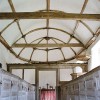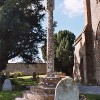What does Eros the archer on his plinth in Piccadilly Circus have to do with what one guide book calls “the Bible-thumping social reformer who campaigned against child labour?” The world-renowned figure high above the London crowds is not in fact the God of Love, but the Angel of Christian Charity, and it commemorates the seventh Earl of Shaftesbury, whose family is closely linked with Dorset. Children were still climbing into chimneys to sweep them when philanthropist Lord Shaftesbury began his quest. Today, as a result of his work, Community Regeneration Projects are improving some of Britain’s most deprived areas.
In his day, Anthony Ashley Cooper, the seventh earl (1801-85), an MP from 1826 to 1851, was the leading spirit in the reform of factory working conditions. He was chairman of the Ragged Schools Union for over 40 years. As late as 1863, young children were still working 16 hours a day.
Shaftesbury’s zeal was directed to the children on his Dorset estate as well as those all over the country. The Wimborne St. Giles School was a model of its kind; it was light and airy with windows small children could see out of and by 1870 it had central heating. He regularly visited the school and Lady Victoria Ashley took a weekly sewing class. The school Log Book records numerous visits by other members of the family. In 1882 there were 120 pupils on the school roll and The Rector of St. Giles came in to help the mistress and her assistant by taking twice weekly scripture classes and pupil teachers also helped. The school had a well-stocked library and pupils were allowed to take books home. The Seventh Earl’s school at Wimborne St. Giles supplied a long-felt need. A Parliamentary Inquiry (1818) revealed that St. Giles children attended a school at Cranborne, necessitating a two-mile walk each way.
There is a story that serves to illustrate Shaftesbury’s concern for the needs of destitute children. He was visiting a Ragged school in London and noticing the distress of a little girl who he asked how she felt, she told him “Ise hungry – Ise cold”. He was moved to tears and had two urns of soup sent to the school from his home in Grosvenor Square. That winter 10,000 bowls of soup and bread from his own kitchens were distributed to hungry children.
The Shaftesbury family had much earlier encouraged the education of local children. The third earl, who lived from 1671 to 1713, was a philosopher and moral reformer who taught that man is guided by a “moral sense”. His housekeeper was instructed to find out which children on the estate needed encouragement and help with their education and she was to report “of their schooling (which my Lord allows them)” and also to say which of them ought to receive further education.
In 1885 the seventh earl came home to Wimborne St. Giles and attended the church where he read the lessons. During July he became ill and sought relief by the sea at Folkestone. His health deteriorated and he died there.
In memory of the man who changed the lives of the poor, Shaftesbury Sunday is celebrated every year near the anniversary of his birth in April, when people recall how he was inspired by his deep Christian faith to pioneer education of the young, to make illegal the use of women and children underground, and to limit factory working hours.
The Shaftesbury Society is the means by which the present generation continues the work. Some of the world’s social reformers have been poor men eager to advance the prospects of their own class but the seventh earl is today remembered in the popular mind more than his antecedents, because although one of the gentry, he could see the need. He went to boarding school, Harrow and Cambridge. Many of the residents of homes for the elderly and those who grew up in orphanages have reason to be thankful for him.



